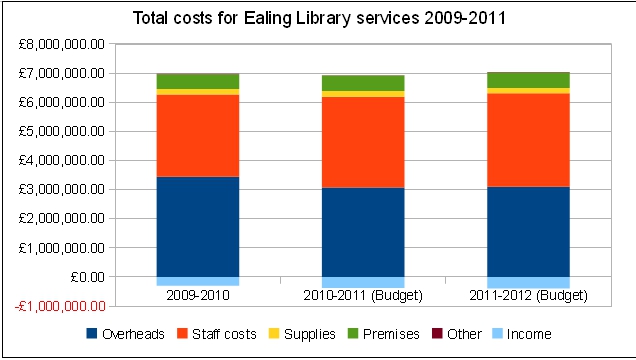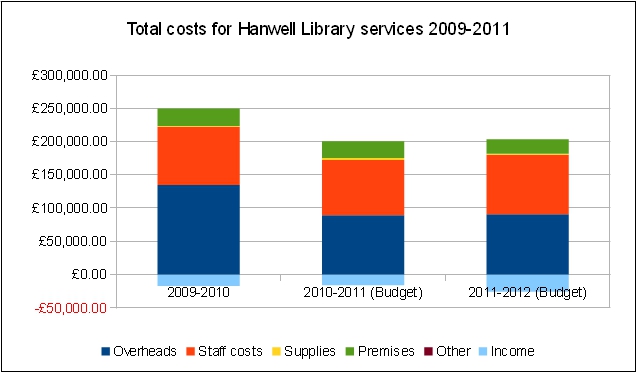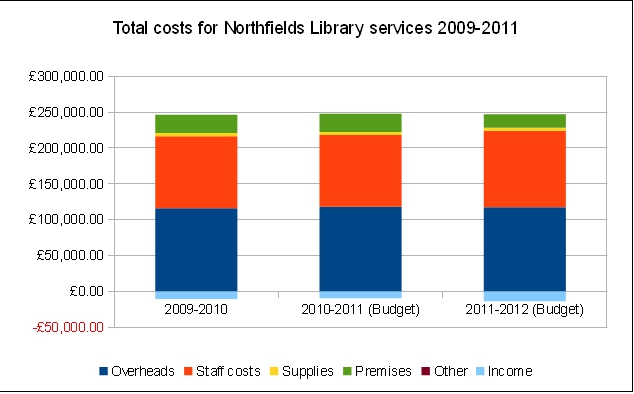As a consultation on library services in the Borough draws to a close, and the threat of library branch closures looms, James Guest of Ealing Fields Residents Association breaks down the costs of Ealing Libraries, and find that the Council needs to take a closer look at libraries’ considerable overheads if they want to make any cuts.
Key points
- Ealing spends £6.7million on libraries annually – £65 million of budget savings are said to be needed
- Overheads make up a high proportion of library costs – over £3 million annually
- The branch libraries targeted for closure are already closed more days a week than other libraries – hence their lower visitor numbers
- Only 42 per cent of current expenditure on libraries goes to staff costs – running libraries on a volunteer basis will not save a great deal of money
According to the Council, Ealing needs to cut over £65million from its annual budget over the next three years – another casualty of the government’s cuts agenda. It has now set its sights on the borough’s library services, an interesting choice given that we spend about £6.7 million on these services annually. It’s already clear that even as much as a 50 per cent cut to these services would contribute only 5 per cent to the total that’s needed over the next 3 years – a veritable drop in the bucket. Both Northfields and Hanwell libraries are in frame for possible closures.
Volunteering isn’t a realistic option
With its consultation the Council is driving forward the notion that some libraries can be staffed by volunteers, and this is reflected in the loaded nature of many questions from the outset. Data provided by the Council shows that 42 per cent of current expenditure on libraries goes to staff costs. This suggests that even if a 100 per cent substitution of paid librarians by volunteers was feasible, it would still leave the Council having to find the money for all the other costs including Heating & Lighting, Book Purchases, Supplies & Services, IT systems, etc.
Scale of the overheads
Overheads make up a high proportion of the costs which the Council are citing as a justification for closing small branch libraries. The ‘problem’ the Council need to address is the scale of the overheads, not the minimal staffing of the branch libraries. Careful examination of the Council’s figures on costs show a significant amount of central overheads that would still be incurred even if the branch libraries were closed. Reducing central overheads could be an alternative to cutting the branch libraries.
If we look at the average total costs across the library services from 2009-2012 (projected), it becomes clear that a reduction in overheads over the whole library system would be beneficial from a cost point of view:

If we break down costs per visitor between overhead and expenditure (minus revenue) for 2009-2010, we find that we are paying more in sunk costs per head. The budgeted fall in overhead costs (in blue) post 2010 will have beneficial cost-per head results.
Visitor numbers – a Catch 22?
The targeted branch libraries are already closed for more days a week than other libraries – hence their lower visitor numbers. ‘Catch 22’ rules! Longer opening hours would mean more visitors to spread the sunk overhead costs around, with only a relatively small increase in staff costs. Overhead costs are allocated on a percentage basis. Hanwell has almost certainly been overcharged in 2009-10 (the year the Council is using to justify including it in the cuts).
‘Wrong’ Overheads used for Hanwell in key year
According to the Council, Hanwell’s allocation percentage was 4.0 per cent in 2009-10, but this drops to 2.5 per cent in 2010-11 and 2011-12. Hanwell’s costs in 2009-10 would have been approximately £40,000 less if the following year’s lower overhead allocation percentages had been used for allocation Library Management and Town Hall costs. If we look at both Hanwell and Northfields’ ration of Overheads to Direct Costs (mostly staff costs), we can see that overheads have made up a large share of total costs (especially in Hanwell) in 2009-2010:


Library stock is allocated to each library on a percentage basis. The total spend on stock for All libraries increases from £406,597 in 2009-10 to £640,000 in 2010-11. In addition the percentage allocation charged to Hanwell increased from 2.8 per cent to 3.4 per cent of the total spend. Whether any of this increased spend and increased percentage arrived at Hanwell is another question.
Some of these fixed overhead costs are shares of the central Council management hierarchy and other costs, such as the computerised lending system, are a fixed cost regardless of how many branch libraries are shut. One could argue that questions 7 and 8 in the consultation about volunteering in the survey are somewhat disingenuous, in that they imply that volunteering is a viable means of achieving the savings target the Council has set for the Library Service. Alternatively, the wording could indicate that the councillors don’t understand the cost structure of the service they are meant to be overseeing.
There is considerable public opposition to cuts to Ealing’s libraries, and to Northfields and Hanwell in particular, as Eric Leach has already discussed on this blog. When the Council has just spend over £600,000 on redeveloping Northfields library (nearly 2 years of operational expenditure!), and millions on new offices and car parks these cuts begin to look far more ideological than practical.
Cut overheads not staff
The Council needs to address the massive Town Hall overheads I’ve described before they start considering shutting highly valued and modestly staffed branch libraries such as Hanwell and Northfields. With the back office overheads making up around half the costs of the Library Service (over £3million) these should be the starting point for any cuts. The Council must avoid making knee jerk decisions about closing branch libraries or trying to run them with volunteers, when there are so many other costs to consider.

